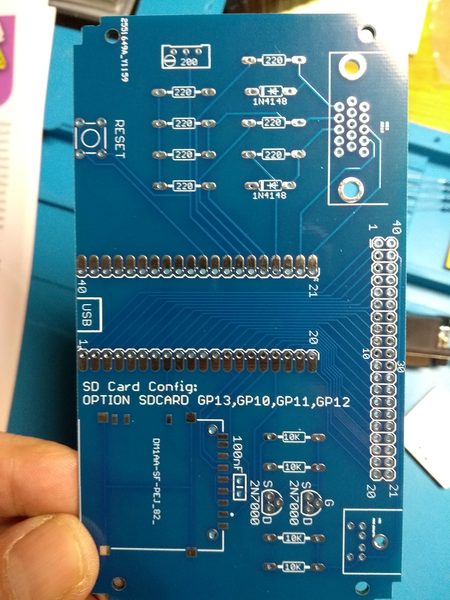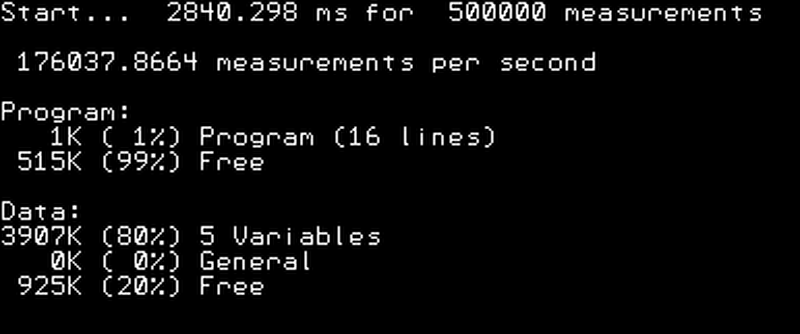Senior Member
Joined: 07/12/2020
Location: GermanyPosts: 226
| Posted: 08:47am 23 Sep 2022 |
2 Mio For..Next Loops
CMM2:

PicoMiteVGA:

The CMM2 (480MHz) is 8.3 times faster than the PicoMiteVGA (126MHz)
The CMM2 has an #include-statement which enables modular software.
-andreas
Guru
Joined: 04/06/2022
Location: GermanyPosts: 1217
| Posted: 09:37am 23 Sep 2022 |
Messung von 2000000 For-Next - Statents
----------------------------------------
Pro Sekunde: 268592
Gesamtlaufzeit: 7.446217
> option list
OPTION KEYBOARD GR
OPTION CPUSPEED (KHz) 378000
OPTION SDCARD GP10, GP12, GP11, GP13
OPTION AUDIO GP6,GP7, ON PWM CHANNEL 3
with OPTION CPUSPEED 378000
~ half as fast as cmm2
Print "Messung von 2000000 For-Next - Statents"
Print "----------------------------------------"
t%=Timer
For f%=1 To 2000000
Next f%
l= Timer-t%
Print "Pro Sekunde: ";Int(2000000/(l/1000))
Print "Gesamtlaufzeit: "l /1000
a littlie faster, if I put the Next statement in the same Line as the For Statement :
Messung von 2000000 For-Next - Statents
----------------------------------------
Pro Sekunde: 275513
Gesamtlaufzeit: 7.259177
but .. if I delete the Variable behind the NEXT Statement
Messung von 2000000 For-Next - Statents
----------------------------------------
Pro Sekunde: 589522
Gesamtlaufzeit: 3.392575

Print "Messung von 2000000 For-Next - Statents"
Print "----------------------------------------"
t%=Timer
For f%=1 To 2000000:Next
l= Timer-t%
Print "Pro Sekunde: ";Int(2000000/(l/1000))
Print "Gesamtlaufzeit: "l /1000
the question remains, how meaningful such test results are
Cheers
Mart!n
Edited 2022-09-23 19:59 by Martin H.
Guru
Joined: 11/02/2018
Location: AustraliaPosts: 2578
| Posted: 12:47pm 23 Sep 2022 |
As an experiment to see how fast a Pico can read a pin in a FOR - NEXT loop I wrote a program to read a DHT11 temp / humidity sensor and found you can fill an array at 15uS per sample.
CPUSPEED = 378000 kHz, a one digit pin number and all on one line. Every character slows it down.
Here is the relevant part.
'Data format - 80uS high start pulse, 50uS low + 25uS high = 0, 50uS low + 70uS high = 1
Dim integer n
' deliver 20 mS pulse to wake up DHT11
SetPin 1,dout,oc
Pin(1)=1
Pulse 1,20
Pause 19
SetPin 1,off
SetPin 1,din 'Get the samples
For n=0 To 329:a(n)=Pin(1):Next
SetPin 1, off 'Got the samples
'for max. speed the above 'for-next' must be on one line with fewest characters
Dim integer n
' deliver 20 mS pulse to wake up DHT11
SetPin 1,dout,oc
Pin(1)=1
Pulse 1,20
Pause 19
SetPin 1,off
SetPin 1,din 'Get the samples
For n=0 To 329:a(n)=Pin(1):Next
SetPin 1, off 'Got the samples
'for max. speed the above 'for-next' must be on one line with fewest characters
Edited 2022-09-24 09:01 by phil99
Senior Member
Joined: 07/12/2020
Location: GermanyPosts: 226
| Posted: 07:41pm 25 Sep 2022 |
Very interesting! So one can sample more than 1/15uS = 66666 samples a seconds using for-next on a pico.

-andreas
Guru
Joined: 05/03/2018
Location: NetherlandsPosts: 5021
| Posted: 07:57pm 25 Sep 2022 |
And 32000000 times per seond using the PIO.
Guru
Joined: 11/02/2018
Location: AustraliaPosts: 2578
| Posted: 11:36pm 25 Sep 2022 |
"And 32000000 times per second using the PIO."
Yes indeed, if you have A Need for Speed.
ADC and CSUB LOG also work well.
Update on the For - Next. The 15uS per sample was before I added
Dim Integer n
That reduced it to 12.4uS per sample = 80,645 samples / second.
I had assumed, wrongly, that the counter in a For - Next would automatically be an integer.
That enables it to catch the 25uS pulses at 252MHz most of the time.
Guru
Joined: 30/03/2016
Location: United KingdomPosts: 1646
| Posted: 04:06am 26 Sep 2022 |
Because it runs from SD?
Craig
Guru
Joined: 30/03/2016
Location: United KingdomPosts: 1646
| Posted: 04:09am 26 Sep 2022 |
Doesn't a decrementing For-Next run even faster?
Craig
Guru
Joined: 30/03/2016
Location: United KingdomPosts: 1646
| Posted: 06:56am 26 Sep 2022 |
For decades, I have been using a high-end industrial controller (read:expensive) which consists of a real-time back-end and an extemely crude BASIC-like interpreter on the front-end.
This interpreter has one data-type which is float. A literal string can be produced using a 2-character mnemonic MG"Hello World" (MG = message).
I have been able to achieve all I need with this language and I never wondered about execution speed because it's never been a concern.
I spent yesterday going through their documentation and the same for other similar high-end products and heck, PMBasic totally blows them out of the water. Turns out that the product I was using ten years ago which I regarded as stupidly fast, has a command execution time of 400uS

Then I moved-on to a newer model that boasted "10 times faster"...40uS...What's that, a MMBasic PIC32MX170 @40MHz?

Their flagship is 11uS and that would cost me close to £4K
Another big-name alternative ($4.4K Used on eBay) cautions about the limitations of their 32bits and single precision. Also runs @ ~25,000 lines/sec.
MMBasic just totally freaking ROCKS!!!
Craig
Guru
Joined: 11/02/2018
Location: AustraliaPosts: 2578
| Posted: 08:04am 26 Sep 2022 |
"Doesn't a decrementing For-Next run even faster?"
I must try it.
Now that you have jogged my decrepit memory I may have done that in the past.
Guru
Joined: 31/01/2019
Location: GermanyPosts: 573
| Posted: 09:11am 26 Sep 2022 |
@andreas where can i find the pcb from your Picomite?
Guru
Joined: 04/06/2022
Location: GermanyPosts: 1217
| Posted: 12:45pm 26 Sep 2022 |
hmm no
Print "Messung von 2000000 For-Next - Statents"
Print "----------------------------------------"
t%=Timer
For f%=2000000 To 1 Step -1:Next
l= Timer-t%
Print "Pro Sekunde: ";Int(2000000/(l/1000))
Print "Gesamtlaufzeit: "l /1000
>
Messung von 2000000 For-Next - Statents
----------------------------------------
Pro Sekunde: 583799
Gesamtlaufzeit: 3.425835
Cheers
Mart!n
Guru
Joined: 11/02/2018
Location: AustraliaPosts: 2578
| Posted: 12:56pm 26 Sep 2022 |
"Doesn't a decrementing For-Next run even faster?"
"hmm no"
Got the same result. What little gain there might have been was offset by the extra characters STEP -1
Senior Member
Joined: 07/12/2020
Location: GermanyPosts: 226
| Posted: 02:30pm 26 Sep 2022 |
Yes, the CMM2 has a SD-Card. But the picos can have a sd-card also. If one uses a pico as data logger, educational hardware, game machine, hobbyist thing - it makes sense to have a mass storage.
#include in MMBASIC is the same as a definition/implementation module in Modula-2 or a DLL in Windows or a word in FORTH. You need it if you want to write code only once for a certain task and create more and more complex software out of simple building blocks.
-andreas
Senior Member
Joined: 07/12/2020
Location: GermanyPosts: 226
| Posted: 02:42pm 26 Sep 2022 |
Hi Plasma, do you mean this one?

This is from Silicon Chip magazin July 22 VGA PicoMite ($5) or Kit ($35).
-andreas
Senior Member
Joined: 07/12/2020
Location: GermanyPosts: 226
| Posted: 03:14pm 26 Sep 2022 |
Don't ask me what is going on here - this version does it in a second!
Can someone verify this? I'm curious where the mistake is - but this seems to be too fast, isn't it?

' speed.bas - Laufzeitmessung
'
CLS
CONST Maxloop = 2000000 ' Anzahl der Loops
DIM Laufzeit AS FLOAT = 0.0 ' in Sekunden
DIM a AS INTEGER = 0 ' Dummy
DIM T1 AS INTEGER = 0
DIM T2 AS INTEGER = 0 ' Timer in Millisekunden
PRINT
PRINT "Messung von ";Maxloop%;" For-Next - Statements"
PRINT "------------------------------------------"
PRINT
T1 = timer
for a = 1 to Maxloop:next
T2 = timer
Laufzeit = (T2 - T1)/1000.0
PRINT "Pro Sekunde: ";INT(Maxloop/Laufzeit);" Iterationen"
PRINT "Gesamtlaufzeit: ";Laufzeit;" Sekunden"
save image "cmm2.bmp"
'
CLS
CONST Maxloop = 2000000 ' Anzahl der Loops
DIM Laufzeit AS FLOAT = 0.0 ' in Sekunden
DIM a AS INTEGER = 0 ' Dummy
DIM T1 AS INTEGER = 0
DIM T2 AS INTEGER = 0 ' Timer in Millisekunden
PRINT "Messung von ";Maxloop%;" For-Next - Statements"
PRINT "------------------------------------------"
T1 = timer
for a = 1 to Maxloop:next
T2 = timer
Laufzeit = (T2 - T1)/1000.0
PRINT "Pro Sekunde: ";INT(Maxloop/Laufzeit);" Iterationen"
PRINT "Gesamtlaufzeit: ";Laufzeit;" Sekunden"
save image "cmm2.bmp"
The CMM2 is not "tuned" it simply runs @ 480MHz.
-andreas
Senior Member
Joined: 07/12/2020
Location: GermanyPosts: 226
| Posted: 06:15pm 26 Sep 2022 |
Using the same code on the PicoMiteVGA (simply by using the same sd-card) I get improved values:

By comparing the old benchmark code to the current code there is one major difference: In the new faster code I did declare the control variable as integer before use within the for..next construct.
Result: Declaring control variables before use results in huge speed-up!
Example:
CONST Maxloop = 10000000
DIM i AS INTEGER = 0 ' gives huge speed-up
FOR i = 1 to Maxloop
'Do_something
NEXT ' do not write i after NEXT
It seem to be very important not to write down the control variable after the next-statement.
Writing: for i = 1 to Maxloop : next
is much faster than
writing: for i = 1 to Maxloop : next i
Doing real measurements on the cmm2 within the for..next loop:

' bench.bas - how fast can you measure
const maxmeasure = 500000 ' number of measurements
cls
dim mess(maxmeasure) as integer
dim i as integer = 0
setpin 33,din ' digital input on pin 33
print "Start... ";
t1 = timer
for i = 1 to maxmeasure: mess(i) = pin(33):next
diff=timer-t1
print diff;" ms for ";maxmeasure;" measurements"
print
print (maxmeasure/diff)*1000;" measurements per second"
print
memory
save image "camac.bmp"
const maxmeasure = 500000 ' number of measurements
cls
dim mess(maxmeasure) as integer
dim i as integer = 0
setpin 33,din ' digital input on pin 33
print "Start... ";
t1 = timer
for i = 1 to maxmeasure: mess(i) = pin(33):next
diff=timer-t1
print diff;" ms for ";maxmeasure;" measurements"
print (maxmeasure/diff)*1000;" measurements per second"
memory
save image "camac.bmp"
-andreas
Edited 2022-09-27 06:46 by andreas